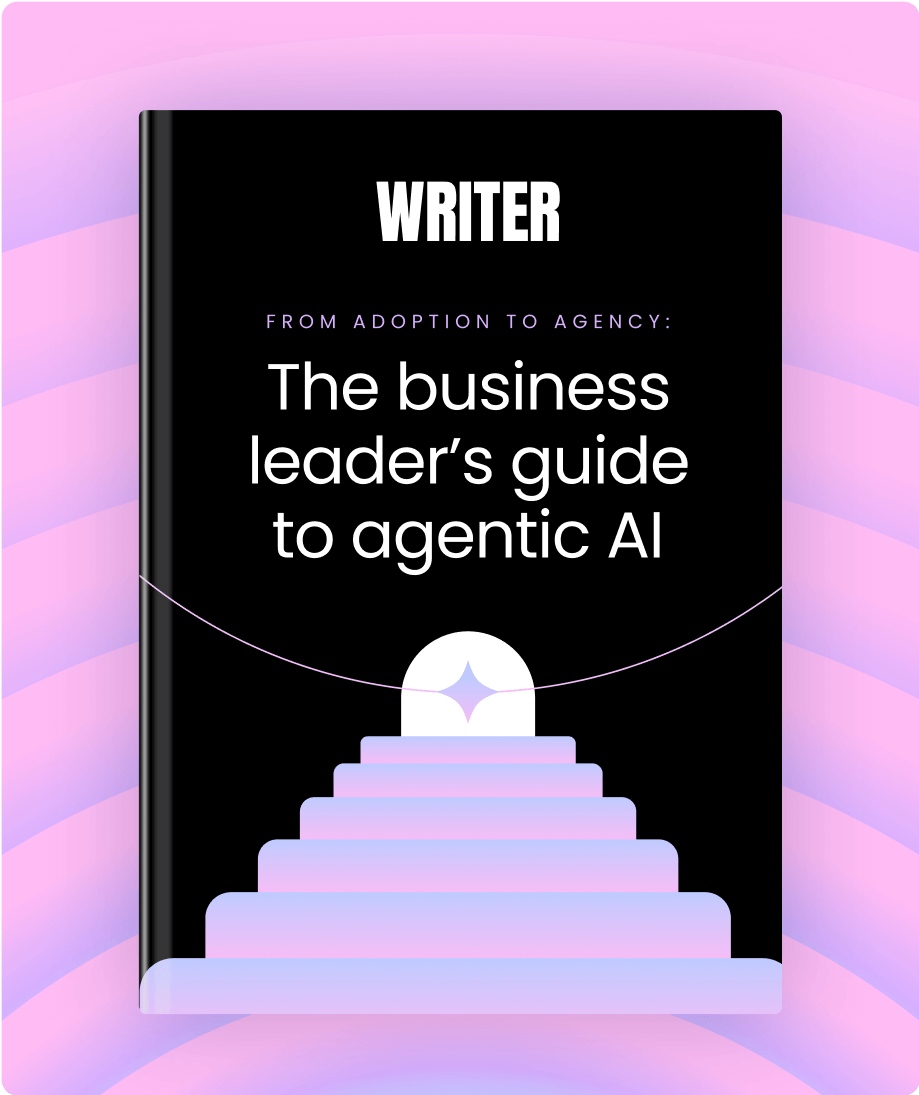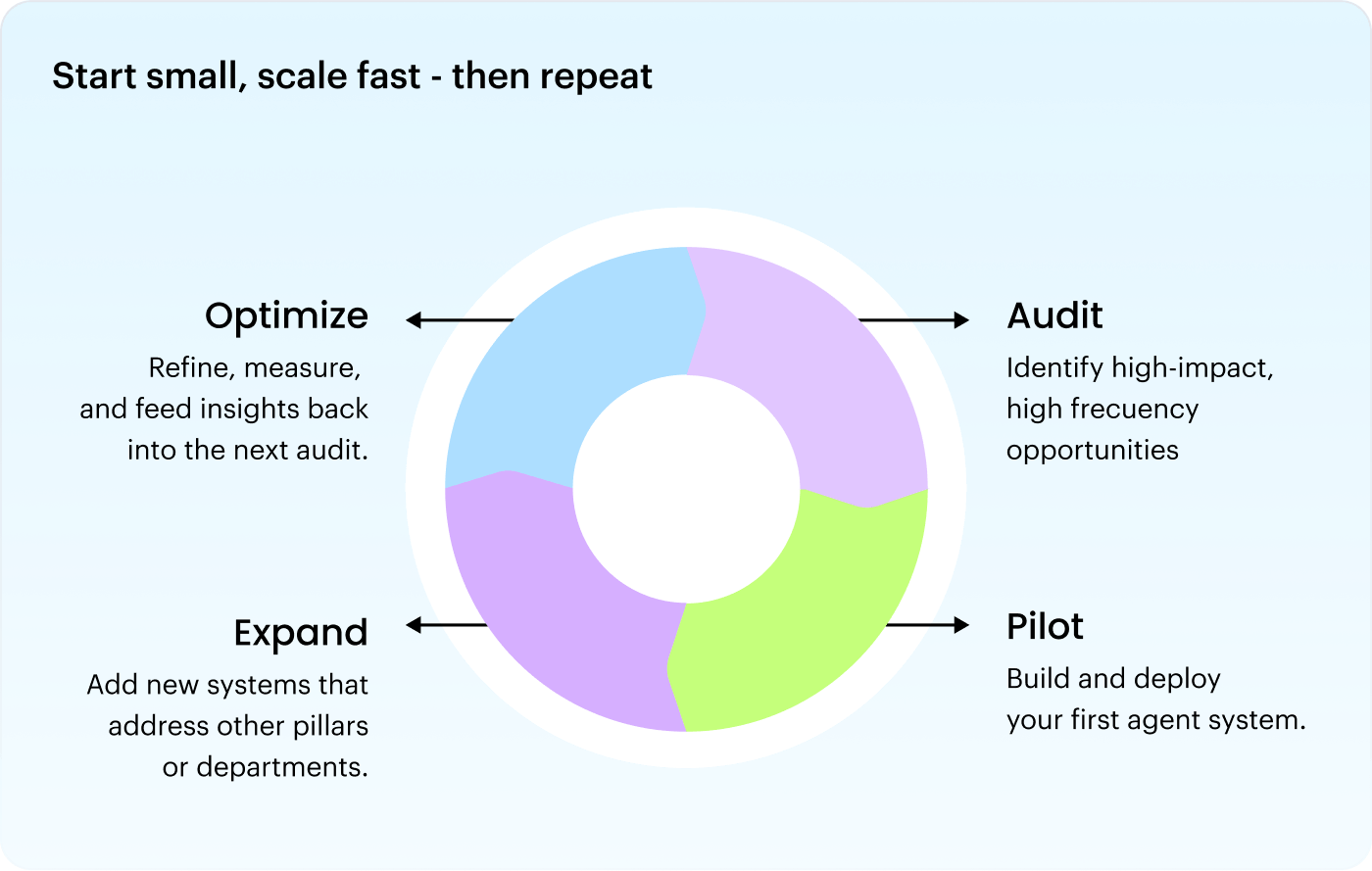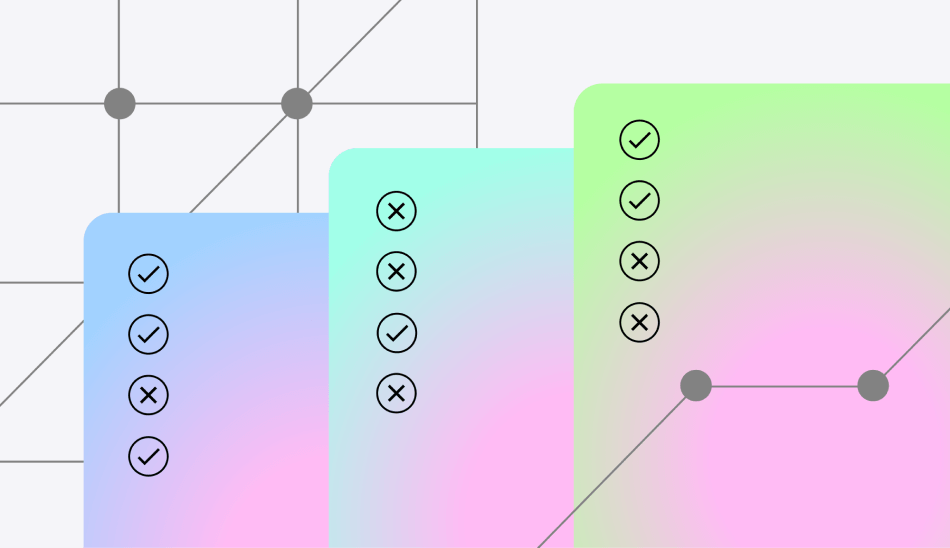From adoption
to agency:
The business leader’s guide to agentic AI

Executive summary: From generative AI to the agentic enterprise
The shift from generative AI to agentic AI marks a pivotal moment for the enterprise. While generative AI provided the spark — automating content creation and answering queries — agentic AI delivers the engine for transformation. It moves beyond generating text to executing end-to-end workflows, connecting disparate systems, and taking action across your entire tech stack. This is the dawn of the agentic enterprise: a business where autonomous agents, powered by your company’s unique data and processes, work alongside your teams to drive efficiency, innovation, and growth.
This guide provides a strategic roadmap for navigating this transition. We introduce the “Crawl, Walk, Run, Fly” framework, a phased approach to adopting agentic AI that aligns with your business’s maturity and goals. From simple assistive agents (Crawl) to fully autonomous, multi-agent systems (Fly), you’ll learn how to build, deploy, and govern AI that delivers real, measurable value. The key is a platform built on three pillars — best-in-class large language models (LLMs), a secure Knowledge Graph of your business, and a strong framework for tool-calling and workflow automation. With WRITER, you have the power to build your own fleet of AI agents and lead your people — and your industry — into the future.

If you think you understand enterprise AI, it’s time to think again. The conversation has moved beyond generative AI that can write and create on command. The new frontier is agentic AI — intelligent systems that don’t just respond to prompts, but actively problem-solve, automate entire workflows, and operate on your behalf to achieve complex goals. For business leaders, this shift from passive generation to proactive agency represents a pivotal opportunity to redefine productivity, innovation, and competitive advantage.
This guide is for you, the business leader navigating this new landscape. It moves beyond the hype cycle to focus on the reality of implementation. It’s not a technical manual, but a strategic map for understanding, adopting, and supervising AI agents that solve real business problems. We’ll explore how to move beyond simple AI adoption and truly empower your organization with a fleet of digital specialists ready to drive measurable results.

Download the ebook
The leap from generative to agentic AI
For the past few years, the focus has been on generative AI — tools that excel at creating content, summarizing information, and answering questions. These models are powerful, but they’re fundamentally reactive. They wait for a prompt and execute a specific, user-defined task.
Agentic AI is the next logical step. An AI agent is a system that can understand a goal, break it down into smaller steps, make a plan, and then execute that plan using a variety of tools and resources — all while learning from feedback. Think of it as the difference between hiring a freelance writer (generative AI) and hiring a project manager/contributor who can oversee and create an entire campaign from start to finish (agentic AI). The former creates an output, but the latter manages and performs a process.
This distinction is critical. As the hype around agentic AI grows, many vendors are engaging in “agent-washing” — relabeling simple chatbots or single-task automations as “agents.” A true AI agent is a sophisticated system defined by its ability to autonomously execute a continuous Sense → Reason → Act loop.
- Sense: The agent perceives its environment, taking in new information, user requests, and data from various systems.
- Reason: It processes this information, formulates a multi-step plan to achieve a goal, and adapts that plan as circumstances change.
- Act: It uses a variety of tools (APIs, databases, web browsers) to execute the steps of its plan in the digital world.
Four essential architectural components power this loop:
- The Large Language Model (LLM): This is the core reasoning engine or “brain.” It’s responsible for understanding goals, decomposing tasks, making decisions, and generating output.
- Tools: These are the agent’s “hands.” They provide the ability to interact with the outside world and take action, such as searching a database, sending an email, or accessing a CRM.
- Memory: An agent must have both short-term memory to manage the immediate task and long-term memory to learn from past interactions and improve over time.
- Planning: The agent must be able to create a step-by-step plan to achieve a complex goal and modify that plan in response to new information or unexpected outcomes.
Without this architecture, a tool is not an agent — it’s a macro. For business leaders, understanding this framework is the first step toward making a meaningful investment and avoiding costly, dead-end technologies.
Bringing these architectural components to life requires a new kind of end-to-end platform — one that provides the building enterprise-grade blocks for creating, activating, and supervising these agents. At WRITER, we provide this by connecting powerful Palmyra, our family of transparent LLMs (the reasoning engine), with a secure Knowledge Graph RAG of your business data (the agent’s memory) and a flexible framework that governs how agents plan and use tools to act.
From crawl to fly: A practical framework for your agentic workforce
The agentic AI landscape is noisy. Everyone’s promising a revolution, but few are offering a roadmap. To build a real strategy, you need to move beyond the hype and understand what’s actually possible.
Think of your agentic adoption journey as a “crawl, walk, run, fly” progression. You don’t need to ‘fly” on day one. The smartest approach is to start with simple, high-value automations and scale your ambition as you build momentum and prove ROI. This framework categorizes agents by their capabilities, giving you a clear path forward.
The four levels of agentic autonomy

1. Assistive agent (Crawl)
Let’s be honest — your teams are drowning in busywork. The assistive agent is your first line of defense. It’s a workhorse designed to automate simple, self-contained tasks that don’t require outside knowledge. Think of it as the ultimate intern, ready to tackle high-volume, low-complexity work.
- Core capability: Prompt-based task automation.
- Your move: Deploy it for the low-hanging fruit. Use it to summarize long documents, generate FAQs, and repurpose content. It’s your fastest path to immediate, measurable ROI.
2. Knowledge agent (Walk)
Your company’s most valuable asset is its institutional knowledge, but it’s likely stuck in silos. The knowledge agent helps set it free. By securely connecting to your internal data — from HR policies to CRM records it uses RAG to deliver answers and insights with the full context of your business.
- Core capability: Context-aware responses based on your enterprise knowledge.
- Your move: Use it to build an expert on-demand. Empower your sales team with instant customer history, give employees a single source of truth for internal questions, and help your engineers navigate technical docs in seconds.
3. Action agent (Run)
This is the critical distinction from traditional Robotic Process Automation (RPA). While RPA bots follow rigid, pre-programmed scripts to mimic human clicks, an action agent uses reasoning to understand the goal. It’s not just following a map — it’s navigating the terrain, allowing it to handle exceptions and adapt to changes without breaking.
- Core capability: Planning, reasoning, cross-system workflow automation.
- Your move: Deploy it to connect your disparate systems. Let it update a Salesforce record, send a personalized email through Marketo, or publish a finished article to your CMS. This is where you start breaking down operational silos for good.
4. Multi-agent system (Fly)
This is the endgame. A multi-agent system isn’t just one agent — it’s a coordinated team of specialized agents working together to automate an entire, complex business process from end to end. A “manager” agent orchestrates the workflow, delegating tasks to a crew of action and knowledge agents.
- Core capability: Full-stack business process automation and orchestration.
- Your move: Target your most complex, high-value workflows. Use it to reimagine how you handle everything from procurement and IT incident resolution to multi-channel product launches. This is where you stop making incremental improvements and start fundamentally transforming how your business operates.
Orchestration is the key to multi-agent system

Building your hybrid team:
How to match the right agent to the right job
Think of this less like buying software and more like hiring a digital workforce. As a leader, your job is to build a balanced, hybrid team where humans are augmented by agents, each assigned to the work they do best. The goal isn’t to replace people — it’s to elevate them by automating the automatable.
Score quick wins with assistive agents.
Start here to build organizational momentum. By automating simple, repetitive tasks, you free up your team for more strategic work and create undeniable proof of value that silences the skeptics.
Turn knowledge into an asset with knowledge agents.
Don’t let your institutional knowledge go to waste. Deploy knowledge agents to turn your internal data into an on-demand, interactive resource that makes everyone on your team smarter and faster.
Connect your business with action agents.
The real cost of software isn’t the license fee — it’s the cumbersome work your team does to make different systems talk to each other. Action agents eliminate that cost by automating workflows across your entire application ecosystem.
Redesign your business with multi-agent systems.
When you’re ready to make a big bet, target a core business process for complete transformation. Multi-agent systems allow you to move beyond task automation to redesigning how work gets done at a fundamental level, unlocking new levels of efficiency and innovation.
Your agentic roadmap:
Use cases from crawl to fly
The journey to full agentic transformation isn’t a single leap — it’s a strategic progression. To make this real, let’s map out what the path from tactical automation to strategic autonomy looks like across your key business functions. This roadmap shows how you can start small with assistive tasks and build towards a future where AI agents are core members of your operational teams, driving entire processes from end to end.

How to prioritize your first agentic AI use cases
Not all automation is created equal. The difference between a vanity project and a value driver is a disciplined approach to prioritization. Your goal is to find the sweet spot where business impact and technical feasibility intersect. Avoid the temptation to chase the most complex, futuristic idea first. Instead, focus on building a foundation of quick wins that solve real pain and fund your more ambitious “fly” initiatives.
Use this simple framework to map your potential use cases.
1. Assess business impact
First, evaluate the potential value to the business. High-impact use cases typically align with one or more of these outcomes:
- Accelerates revenue: Does it shorten the sales cycle, improve lead quality, or increase customer lifetime value?
- Reduces operational costs: Does it automate a high-volume, repetitive task that consumes significant human hours?
- Targets high-frequency work: How often is this task performed, and by how many people? A simple task performed hundreds of times a day across the company often represents a larger operational drag than a complex task performed once a month. Automating this “long tail” of inefficiency frees up collective hours for more valuable work.
- Improves customer experience: Does it resolve customer issues faster or provide more personalized, proactive support?
- Mitigates risk: Does it enforce compliance, improve accuracy in regulatory reporting, or enhance security protocols?
- Boosts employee productivity: Does it eliminate the tedious, “soul-crushing” work that prevents your team from focusing on high-value strategic activities?
2. Evaluate feasibility
Next, get real about how achievable the use case is today. A brilliant idea is useless if you can’t execute it. High-feasibility use cases have these characteristics:
- Well-Defined Processes: The workflow is already documented, consistent, and understood. You can’t automate chaos.
- Accessible Systems: The required applications (e.g., your CRM, ERP, CMS) have APIs that an AI agent can connect to. “Tool calling” requires a door to knock on.
- Available, Structured Data: The agent has access to the clean, reliable data it needs to make decisions.
- Clear Success Metrics: You can easily define what “done” and “good” look like. How will you measure the agent’s performance?
3. Map your opportunities
Now, plot your use cases on a simple 2×2 matrix to reveal your strategic path forward.

Your move: Don’t do this in a vacuum. Assemble a cross-functional team of business, IT, and operations leaders. Give them this framework and a whiteboard, and have them map your organization’s biggest opportunities. Your first agentic hire should come directly from that “Quick Wins” quadrant.
A strategic framework for adopting agentic AI
Successfully transitioning to an AI-empowered workforce isn’t just about managing a project — it’s about leading a fundamental change. The most significant barrier to AI adoption isn’t technology — it’s organizational inertia and fear. As a leader, your role is to guide your teams through this transition with a deliberate and empathetic strategy.
This begins with demystifying AI. Don’t let speculation fill an information vacuum. Create a clear narrative about why the company is adopting agentic AI, focusing on opportunities for growth, innovation, and more meaningful work. Frame AI agents as “digital teammates” that handle repetitive tasks, freeing up human employees to focus on strategy, creativity, and complex problem-solving — the work they came on board to do.
Here’s a three-phase framework to guide your journey:
Phase 1: Lay the groundwork with strategy and governance
Before deploying a single agent, you must build a foundation of trust and collaboration.
- Foster cross-functional partnership: The most successful AI initiatives are born from a close partnership between IT and business units. Our research shows that a lack of collaboration is a primary risk factor. Create a formal structure, like a Center of Excellence (CoE), to bring these teams together. This group will set policies, define best practices, and ensure that technical solutions are directly aligned with high-value business goals.
- Establish a clear governance and security framework: A strong governance model is non-negotiable for building trust. Your CoE should define “human-in-the-loop” processes, clearly delineating which tasks can be fully automated and which require human review. Be transparent with your teams about how company and customer data is being used and protected within the AI platform.
Phase 2: Build momentum through people and pilots

With a strategic foundation in place, you can begin implementation by focusing on your people.
- Launch a high-value pilot program: Start with a small, well-defined pilot program focused on a high-value, low-risk use case. This will allow you to learn, iterate, and generate a tangible success story that builds momentum for a broader rollout.
- Define new roles and responsibilities: The pilot is the perfect opportunity to define who is accountable for each part of the agent lifecycle. Identify your workflow owners (business experts), agent builders (the empowered employees testing the platform), and AI operators (those who will monitor performance).
- Equip and empower your people: Successful adoption happens when employees feel confident and capable. Invest in training that goes beyond basic software use, such as workshops on workflow design and how to “supervise” AI agents. Identify enthusiastic early adopters from the pilot group to become AI champions who can share their knowledge and provide peer-to-peer support.
Phase 3: Scale intelligently with measurement and iteration
Once your pilot proves successful, you can scale your initiatives by focusing on value and continuous improvement.
- Establish a holistic ROI framework: To measure true success, look beyond simple productivity metrics. Define clear KPIs across four key quadrants: Efficiency (cost and time savings), Growth (revenue and customer retention), Risk (compliance and security), and Innovation (employee satisfaction and new ideas). This holistic view ensures you capture the full business impact and can make smarter decisions about where to invest next.
- Create a culture of continuous improvement: Agentic AI is a rapidly evolving field. Create a feedback loop where users and stakeholders can share their experiences to identify areas for improvement. Stay up-to-date with the latest developments and continuously refine your AI workflows to add new value.
The challenges of integrating agentic AI across an enterprise
The promise of agentic AI to transform a company is immense, but realizing that potential requires navigating a few common hurdles. For enterprises adopting agentic AI, the goal isn’t just to deploy new technology, but to integrate a strategic workforce of AI agents that drives real business results. Here are the key areas where a thoughtful approach makes all the difference.
Ensuring reliable, on-brand work:
Autonomous agents built on generic models can execute tasks with incorrect information, operate off-brand, or perpetuate harmful stereotypes. When an AI agent completes a task inaccurately or in a way that doesn’t align with your brand, it undermines your operational integrity and can damage your reputation. The key is to deploy AI agents that are trained on your own data and brand specifications, ensuring every completed task is a true reflection of your company.
Safeguarding your data and IP:
Your proprietary data is one of your most valuable assets. When employees use public AI agents, they might use sensitive information in their operations and potentially expose it. Plus, agentic AI can inadvertently use external data that infringes on existing copyrights. A true enterprise-grade agentic AI platform must be a secure, closed system, guaranteeing that your data remains yours and that the work agents perform is clean.
Navigating the complex regulatory landscape:
The legal and ethical landscape for AI is constantly evolving. Work performed by AI agents can risk violating regulations or crossing ethical lines, leading to significant legal and financial consequences. Instead of navigating these “grey areas” alone, an experienced enterprise partner can provide the technological guardrails and expertise to ensure your agentic AI strategy is compliant and responsible.
Smooth integration into core workflows:
The biggest barrier to agentic AI adoption isn’t the technology itself — it’s integrating AI agents into the work people do every day. True transformation happens when AI agents are embedded directly into your existing systems and workflows, from marketing and sales to HR and legal. This requires a platform built for deep integration and an expert partner to manage the change, ensuring your teams are empowered, not disrupted.
Overcoming these challenges isn’t about finding a simple tool — it’s about choosing a partner with the experience, expertise, and technology to turn AI’s potential into tangible business impact. WRITER, the enterprise platform for AI-powered work, is designed to mitigate these risks and accelerate your journey. It enables you to embed a secure, on-brand, and high-quality agentic workforce across your most critical business functions.
Ensuring operational safety when using agentic AI
Think of deploying AI agents as hiring a new team of highly efficient, but very literal, digital employees. Just as you wouldn’t give a new hire the keys to every system on day one without supervision, you must establish clear rules of engagement for your agents. This requires a proactive approach to management and oversight built on the following principles:
- Audit the entire workflow, not just the output: Go beyond content reviews by auditing the outcomes and the specific actions agents take to ensure the end-to-end process aligns with your operational goals.
- Require human-in-the-loop for deployment: Implement rigorous approval workflows, so that any changes to automated processes are vetted by human stakeholders to prevent unintended consequences.
- Enforce the principle of least privilege: Treat each agent like an employee by enforcing strict, role-based access controls (RBAC) that limit its access to only the systems and data necessary for its designated tasks.
- Define clear escalation paths: Establish clear protocols for how agents should respond to unexpected errors, including an escalation path to a human operator when an agent cannot resolve an issue on its own.
- Monitor performance in real-time: Use dashboards and alerts to continuously monitor agent performance and workflow integrity, allowing you to identify deviations before they become critical issues.
- Measure business impact and ROI: Measure the performance of each automated workflow with clear KPIs to quantify its business impact, optimize processes, and demonstrate value.
- Adopt an enterprise-grade platform: Choose one that provides the necessary tools, security, and supervision capabilities to ensure your AI agents operate safely and effectively. A platform like WRITER offers a secure, reliable, and compliant solution for deploying agentic AI.
How to secure your systems and data
Many businesses have already adopted some form of generative AI, but agentic AI introduces a new issue that requires a sharp focus on security and privacy. When you grant AI agents access to your applications, databases, and code repositories, the security paradigm shifts from governing content to governing actions. The primary risk is no longer your data being used to train a language model, but an agent taking an unintended or malicious action within your systems.
Your CIO and CISO will have critical questions before connecting an AI agent platform to your infrastructure. You can prepare for these conversations by asking your vendor:
- How do you control what actions an agent can perform?
- What is your framework for agent operational safety, and how is it enforced?
- How are audit trails implemented to track every agent’s decision and action?
- How do you ensure agents don’t misuse or exfiltrate our intellectual property?
- How do you detect and mitigate bias in agent decision-making?
- How is my data logically and physically isolated from other customers?
- How is my data protected at rest and in transit?
- What role-based access controls (RBAC) are available for managing the platform?
- How does the platform integrate with our existing security tools and identity providers?
- What industry compliance standards and certifications does the platform meet?
Your first 90 days: An action plan for the agentic enterprise
Adopting agentic AI is a journey, not a destination. Use this 90-day plan to build momentum and deliver early wins.
Days 1-30: Identify & plan (crawl)
Goal: Identify the most promising initial use cases and build your core team.
Actions:
- Assemble your AI council: Bring together leaders from IT, data, security, and key business units.
- Host a use case workshop: Using the “Impact vs. Feasibility” matrix, brainstorm and prioritize potential agentic AI applications. Focus on high-impact, low-complexity tasks for an early win.
- Select your first use case: Choose a “Crawl” stage project, like automating a specific content creation or data entry task.
- Connect your knowledge: Begin connecting your company’s core data sources (wikis, SharePoint, etc.) to the WRITER Knowledge Graph to provide a secure foundation for your agent.
Days 31-60: Deploy & validate (walk)
Goal: Accelerate value by deploying a pre-built agent or building a custom one.
Actions:
- Option A: Deploy a pre-built agent: Review WRITER’s library of pre-built agents for common use cases (e.g., social media content creation, meeting summarization). Deploy one that aligns with your initial goals for immediate value.
- Option B: Build your assistive or knowledge agent: If a pre-built agent doesn’t fit, work with your team to configure a custom assistive or knowledge agent. Define its purpose, permissions, and guardrails.
- Pilot program: Roll out the chosen agent to a small, controlled group of users. Gather feedback on its performance, usability, and impact.
- Develop a measurement framework: Define the key metrics you’ll use to measure success (e.g., time saved, error reduction, user satisfaction).
- Identify your next agent: Based on initial learnings, scope out your next project — either another pre-built agent or a custom agent.
Days 61-90: Scale & evangelize (run)
Goal: Expand the use of your first agent and communicate its success across the organization.
Actions:
- Wider rollout: Based on pilot feedback, refine the agent and expand access to the broader team or department.
- Share the success story: Create an internal case study with your pilot group. Showcase the metrics and testimonials to build excitement and buy-in for future projects.
- Begin your “run” project: Kick off development and deployment of an action agent that connects multiple systems to automate a more complex workflow.
- Update your roadmap: Revisit your use case roadmap with the AI Council, incorporating learnings from your first 90 days to plan the next phase of your agentic journey.
WRITER: Your partner in enterprise AI adoption
The journey to becoming an AI-powered enterprise is not just about acquiring new technology; it’s about strategic transformation. According to our 2025 enterprise AI adoption report, 94% of executives are not fully satisfied with their AI vendors, citing a lack of customization and insufficient implementation support as primary concerns. This underscores a critical truth: the right platform is only half the equation. The right partner is the other.
Success in the new age of AI
Success in the new age of AI depends on a vendor that acts as a true partner — one that goes beyond the initial sale to ensure deep, sustainable adoption. This is the core of WRITER’s philosophy. We combine an intuitive, full-stack platform with a dedicated, expert customer success team to guide you from your first use case to enterprise-wide scale.
A foundation of collaboration
Our approach relies on collaboration. It starts with our AI program management and customer success specialists working alongside your business leaders to identify and prioritize high-impact use cases. We don’t offer a one-size-fits-all solution — instead, we provide the tools and guidance to build custom agents and workflows tailored to your unique business needs.
“The WRITER customer support team enabled me to share with my executives why generative AI was the right decision for us, as well as helping me understand what the day-to-day users would need.”

Hands-on support for every facet
Our hands-on support extends to every aspect of implementation:
- Security and Compliance: Address complex requirements with features like our Knowledge Graph.
- On-Site Workshops: Hosted to prepare your organization for change.
- Continuous Learning: Provided through the WRITER AI Academy to help you define new roles, empower internal AI champions, and foster cultural acceptance.
Pilot programs for quick wins
We start with pilot programs designed to deliver quick wins and build momentum. For example, at Qualcomm, an initial pilot resulted in 100% of users wanting to adopt the platform full-time, leading to rapid expansion across multiple departments. We then work with you to measure and communicate the impact of these initiatives, tracking predefined KPIs to justify investment and prove ROI.
Empowering self-sufficiency
Our ultimate goal is to empower you to become self-sufficient in your AI programs. As Albert Primo, chief innovation officer at Kaufman Rossin, stated:
“The WRITER customer success team has been essential in driving adoption. They’re so engaged that it feels like they’re a key part of our team and a strategic partner.”

A commitment to your success
By integrating a powerful, intuitive architecture with an unwavering commitment to customer success, WRITER doesn’t just sell you a platform — we guide your AI journey from start to scale, ensuring your investment translates into measurable, long-term value.

How to evaluate LLM and generative AI vendors for enterprise solutions
Learn more on the blog

